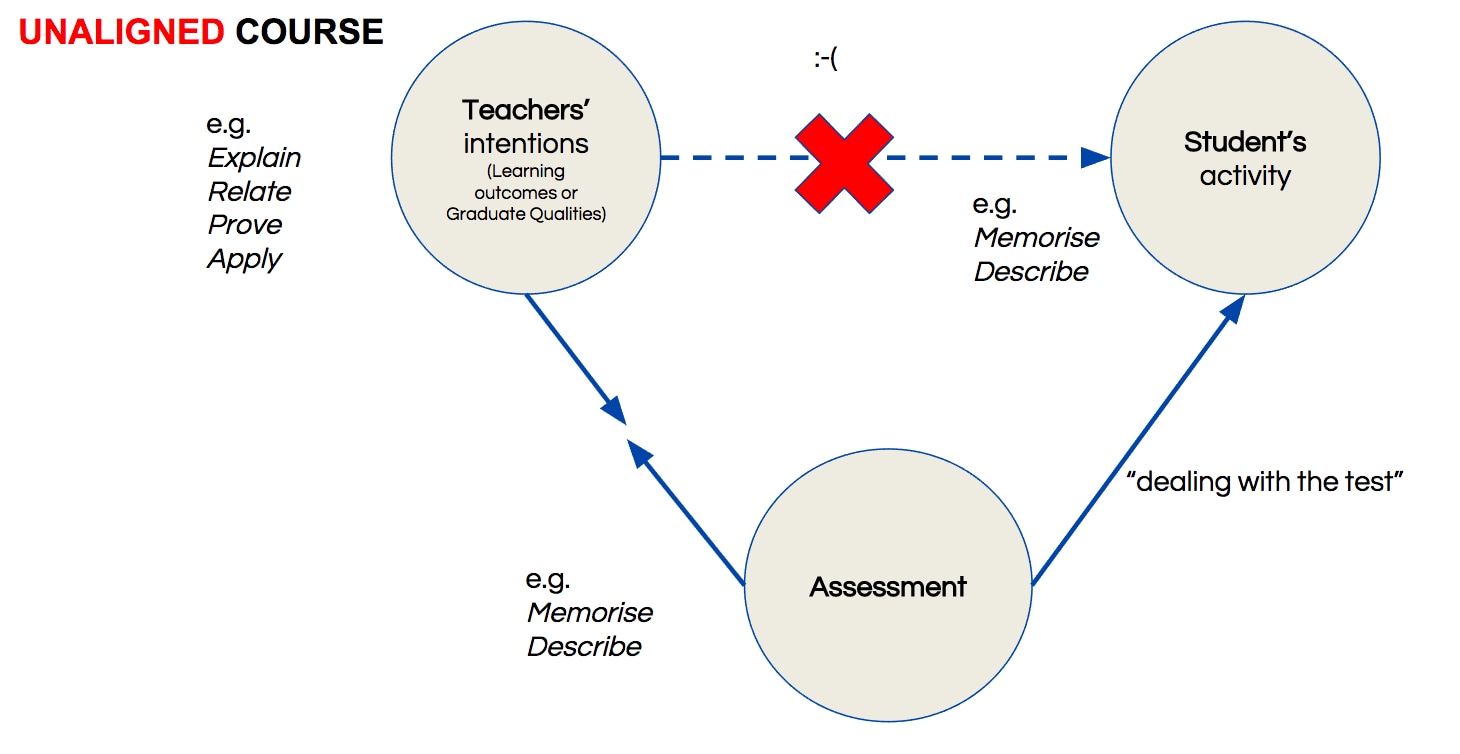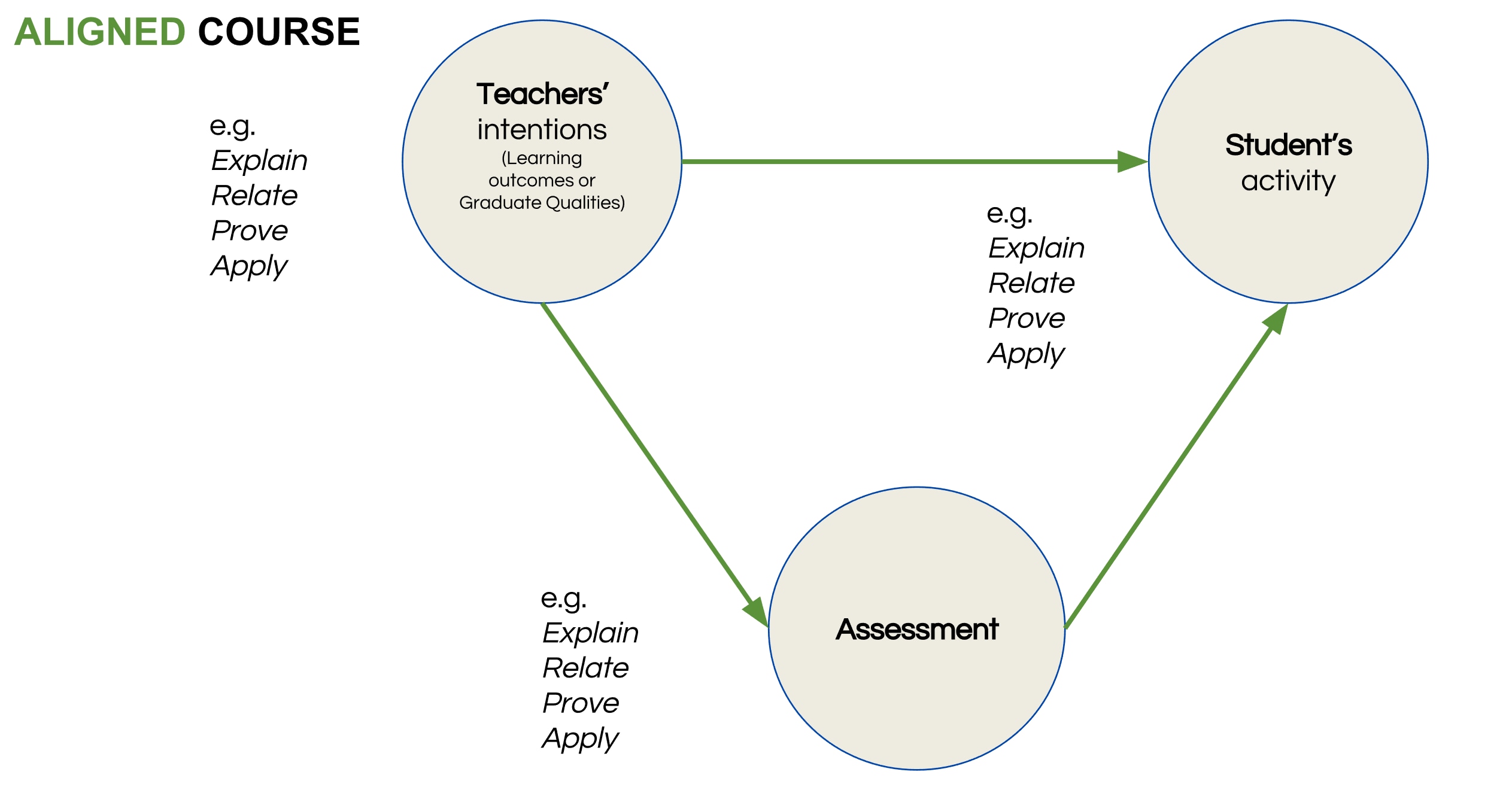Whether you are designing from scratch, or revising an existing course or subject, a few key principles can help steer you in the right direction.
Learning outcomes
Learning outcomes are a mandatory part of all units of study. In being focused on the student, most learning outcomes start with some kind of student or outcome centred claim: “On successful completion of this course students should…” or “Students will be able to…” . Like their name suggests, learning outcomes articulate the expected knowledge or skills that a student will be presumed to have acquired through a particular unit, program or degree. Though learning outcomes say what the student should learn, they are, for the most part, created by the teacher or course co-ordinator. As a teacher the goals or intentions that you have for your students may range quite widely, from anything from traditional knowledge of various principles, concepts and facts through to attitudes or even physical abilities such as knowing how to use a tool or piece of equipment. Learning outcomes can also include things like graduate qualities like leadership, teamwork or communication skills.
In designing a course and writing a set of learning outcomes we ideally aim to bridge the divide between what we as educators want and what a student will invariably do. For this, and other reasons, curriculum design can be especially difficult. How do we know that the course we design and teach will achieve its intended outcomes? Fortunately the prevalence of outcomes based curriculum design has meant that there are a lot of readily accessible resources (see here and here) that don’t need a doctorate in Education to follow.
Constructive alignment
To implement learning outcomes the idea of constructive alignment can be helpful. Constructive alignment is a concept propounded by Professors John Biggs and Catherine Tang. At the simplest level it means that you design the different parts of your course (assessment, learning activities and learning outcomes) so that they perform properly together. The name ‘constructive alignment’ gets its name from ‘constructivism’ – the theory that learners use their own activity to construct their knowledge and ‘alignment’ the positioning of different components to each other so they perform properly.
EXAMPLE: An unaligned course
In a simple hypothetical course the teacher may want the students to explain, relate, prove and apply. However, if the assessment (e.g. test, exam, essay) only assesses students’ ability to memorise and route learn then many students, so the theory goes, will just focus on this to “deal with the test”.

EXAMPLE: An aligned course
In contrast, in an aligned course the assessment will align with the learning outcomes the teacher has set. In this way, a student looking to pass a subject has no shortcut. What the student does in their learning activities and assessments aligns with the aims that the teacher has set.

This theory is explained in Part II of the documentary film Teaching Teaching and Understanding Understanding. Though there are some detractors to constructive alignment as a theory, the general principles still offer a useful concept through which to practically structure or redesign any course or program.
Constructively aligning your course
The experience of trying to align various learning outcomes to activities and assessments is not always easy and can often feel like something of a Rubrics cube. Changes to one part of the course frequently go on to impact others. However, taking the time to do this is worth it. Constructively aligned course have been linked to higher rates of student satisfaction, deep approaches to learning and improved student performance.
Implementation
Following the behind the scenes work of mapping and matching each component of your unit of study is the task of implementing this within your teaching. For a course to truly be considered as ‘constructively aligned’ the student needs to perceive how the pieces of the course fit together. This means that the course outline needs to be not only meaningful to other academics, department heads or education experts, but to the person for whom the entire enterprise is devoted: the student. To do this you make sure that the learning outcomes and assessments are clearly worded and articulated to students throughout the semester. Too often the labour of writing good learning outcomes is wasted is they languish in the pages of unread Unit of Study outlines.
Key tips:
- Make sure learning outcomes are assessable: you cannot assess ‘general appreciation for art’ or ‘wonder at the Universe’ – even if these are things that you may hope some of your students may go on to develop.
- Translate big graduate qualities into the specific context of your subject: Your one subject cannot teach all communication skills ever needed, but you can look at the specific way it may be operationalised within your subject.
- Keep learning outcomes short and simple: Don’t try and cover too much ground – especially for a single unit of study. Learning outcomes should be broader than the individual tasks that make up the subject but narrower than the aims of the wider program. For a single unit of study, aim for a smaller number of well worded outcomes than an unrealistic wish list: 4-6 well-worded outcomes will be more useful than 10-12 lengthy and poorly worded outcomes. As the great philosophical riddle goes: “if a student doesn’t read a learning outcome, does it really exist”.
- Make learning outcomes your students can understand: Learning outcomes need to be understood by your students. Adopt plain English and avoid unnecessary jargon.
- Refer to learning outcomes throughout the semester: Don’t let your learning outcomes linger in the back of your unit outline. Make sure it is clear what the aims of the course are and refer to these as you go along.






1 Comment